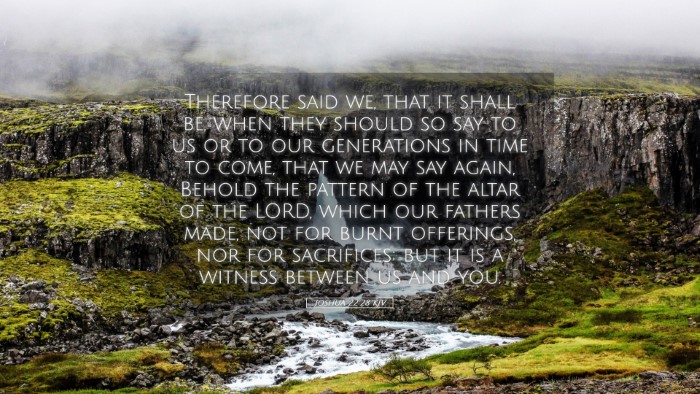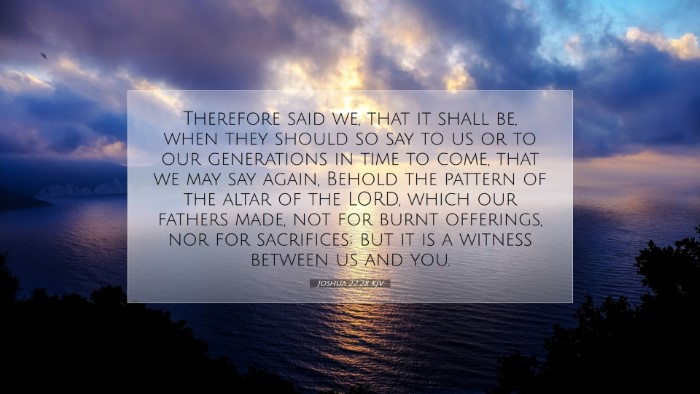Bible Commentary on Joshua 22:28
Joshua 22:28 states:
“Therefore said we, that it shall be, when they should say so to us, or to our generations in time to come, that we may say again, Behold the pattern of the altar of the Lord, which our fathers made, not for burnt offerings, nor for sacrifices; but it is a witness between us and you.”
This verse acts as a crucial pivot in the discourse between the tribes of Reuben, Gad, and the half-tribe of Manasseh and the other tribes of Israel. It encapsulates profound theological and communal themes that warrant careful examination. Below are insights compiled from esteemed public domain commentaries.
Contextual Analysis
The tribes mentioned, having settled east of the Jordan River, faced suspicion from their fellow Israelites regarding the intentions behind building an altar. The altar was meant to serve as a witness and reminder of their shared heritage and covenant with God. Understanding this context allows us to appreciate the depths of their concerns.
The Importance of Remembrance
Matthew Henry emphasizes the significance of memorials within Scripture. He notes that this altar was a potent reminder of divine faithfulness—a pattern for future generations. Henry suggests that it was essential for the tribes to maintain identifiable symbols of faith that would resonate through time.
Symbolism of the Altar
Albert Barnes draws attention to the altar's role as a symbol and not merely a place for sacrifice. The tribes articulated that their purpose was not to usurp the central sanctuary at Shiloh, but to create a communal identity and faith legacy that transcended geography.
Unity and Division
Adam Clarke articulates a crucial theme of unity amidst diversity in worship and practice. The response from the western tribes illustrates an important biblical principle: the need for clear communication and understanding to prevent division among God’s people. Clarke stresses the need for vigilance in maintaining unity while honoring differing expressions of faith.
The Principle of Communication
This verse underscores the importance of communication within the body of Christ. It serves as a reminder to leaders, pastors, and congregations alike that misunderstanding can lead to mistrust. How we convey our faithfulness and intentions to others is pivotal in fostering unity.
Application for Ministry
For pastors and spiritual leaders, this passage offers a rich resource for applying principles of discernment and dialogue. The proactive stance of the eastern tribes in building an altar speaks to the need for establishing clear boundaries and purpose in ministry endeavors.
- Effective Communication: Encourage transparency and open dialogue to avoid misconceptions.
- Building Relationships: Foster relationships that transcend geographical or cultural barriers within the church.
- Heritage and Legacy: Inspire congregants to engage with their spiritual heritage as a foundation for future generations.
Theological Implications
This passage raises important theological discussions regarding identity, worship, and covenant. The altar served as a tangible reminder of their covenant with Yahweh. It highlights the collective identity of God’s people and the shared commitment we have towards Him and each other.
Conclusion
Joshua 22:28 serves as a profound reminder of the importance of symbols in the community of believers, the necessity of effective communication, and upholding communal values that transcend geographic divisions. The rich insights from Matthew Henry, Albert Barnes, and Adam Clarke provide a layered understanding that encourages pastors, students, and theologians to reflect on their own practices of faith communication within the church. As we go forth, may we remember this call to unity and heritage in our Christian walk.


